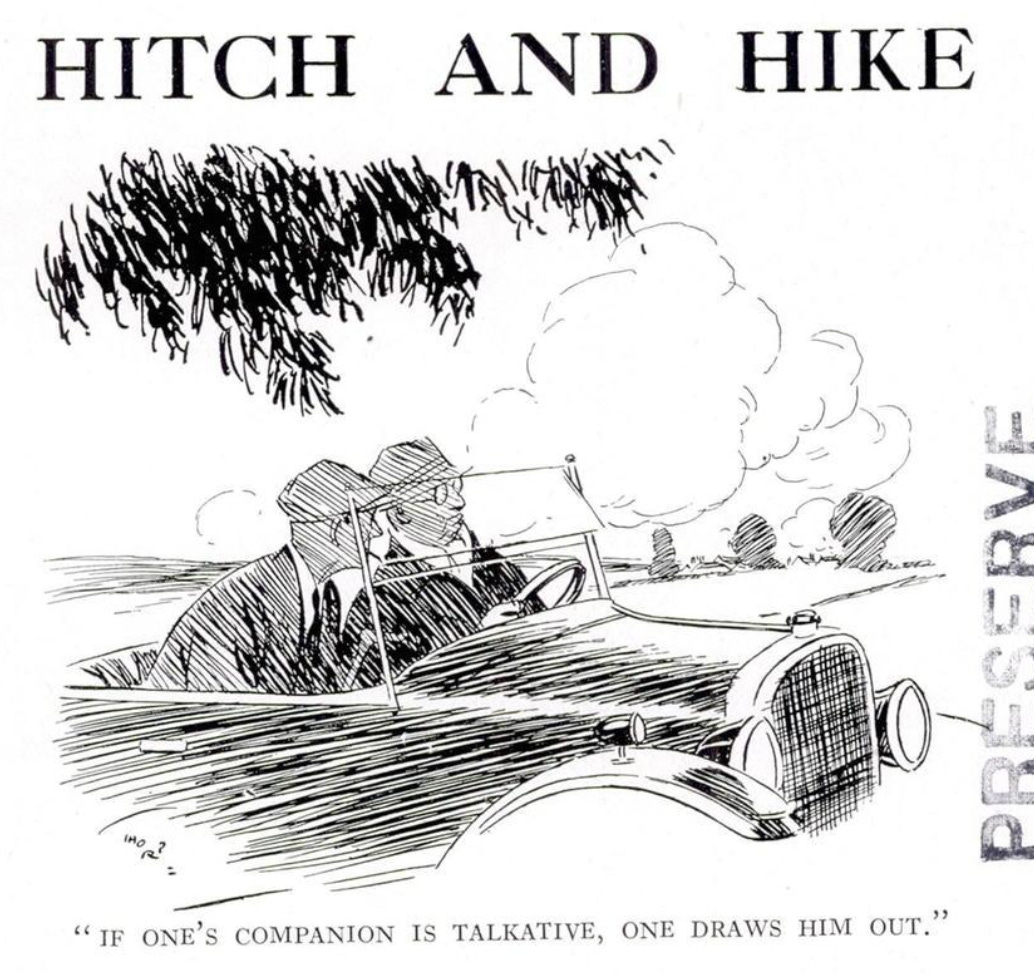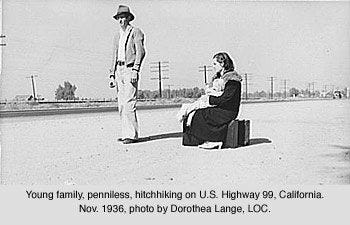‘In no other way could I have gained such a knowledge of the country and the people who made it, and are making it,’ wrote Charles Brown Jr in 1916, ‘Best of all, it gave me a deeper understanding of human nature.’
Perhaps the first intentional hitchhiker (see the last chapter), he was certainly one of the first to wax lyrical about it, but over the next few decades, so did many others. By the end of the Second World War, hitchhiking appeared much as it does today, with the same fervent support from those who enjoy it, and the same fears, tropes and horror stories from just about everyone else.
As with many acts of benevolence, crisis led to a boom, and the early 20th century had no shortage of crises. One by one, they all served to bake hitchhiking into the fabric of the times.
Unbuttoning by the Roadside
While Brown was proselytising his new method of transport, soldiers and nurses both sides of the Atlantic were hailing rides to and from the military camps of the First World War. American soldiers found it relieved the boredom of life in camp, thousands of miles from the conflict. British nurses found a sense of freedom in it.
The poet Robert Graves wrote that the practice lingered after the war, along with other ‘loose habits’ like ‘talking to fellow travellers in railway carriages without embarrassment,’ and ‘unbuttoning by the roadside without shame’.
Once again, hitchhiking’s rise tracked that of the car. By 1920, there were some 10 million in the US, by 1925, double that, and by 1930, nearly triple.
As automobiles sped forward, roads rose up to meet them. Long tongues of fresh tarmac licked the landscape, girdling North America and Britain alike, black ribbons of the future, carrying men, women, families, salesmen, soldiers and anyone else to wherever they pleased to go.
‘Gradually the possibilities of the open road are being recognised’, wrote Country Life in an article titled ‘Hitch and Hike’ in 1926.
‘For those of a roving disposition, there are few things more satisfying than the United States’ entertainment of hitch and hike… ‘Vile parasite I could not do such a thing’ growls the prosaic one. But, of course, the prosaic one has no desire to see the world. He is too busy building a fortune for someone else to trouble about such selfish considerations as his own enlightenment….’
The 20s saw hitchhiking clarify into what we know it as today, finding a name and its symbol—the thumb. Quite where either came from is unclear, though the title of the Country Life article is as good an etymology as any.
Watch Clark Gable attempting to catch a ride in the 1934 movie It Happened One Night.
A Strike and the Dust Bowl
Still, for all its growing prevalence, hitchhiking was generally the preserve of the adventurous. It was only during times of crisis that it took on a wider appeal.
Such a crisis first came in Britain. The General Strike of 1926 only lasted two weeks and saw all public transport halted as trade unions demanded higher wages. The country ground to a halt.
The car-owning upper classes quickly found a way of doing their bit to undermine it. They thoroughly enjoyed picking up workers, filling their empty seats with as many as possible to derail the strikes.
‘Civilisation must, if it has any reality, any value, make us ready to give anyone a lift in any way possible, not only at moments of crisis, but in ordinary humdrum times,’ trumpeted the Daily Herald as the strike came to an end.
But without their ulterior motive, many car owners were suddenly less willing to share their vehicles. Punch joked that drivers should employ inflatable passengers to deter ‘importunate lift cadgers’.
In America, meanwhile, the crisis, when it came, hit harder and longer.
‘Probably only in the United States could one see the phenomenon of beggars in automobiles,” wrote The Manchester Guardian’s New York correspondent in 1932, in the bitter wake of the Wall Street Crash.
Strange hordes of vagrant men, women and children were seen drifting along the highways, sure that fortune lay just beyond the brow. Many drove their own cars, which were often all they had. Those who couldn’t afford them hitchhiked.
A year later, the same paper said there were 140,000 women tramping across the continent. ‘You will usually hear much the same story,’ the piece records, ‘She comes from a town where times are bad, but she had heard that things were better in some other city a couple of thousand miles away. So she set out to "hitch hike" to the promised land.
‘When she got there things were just as bad as at home, but there were rumours about a third city, so she set off again… In any case, organised charity appears far more humiliating than the casual sort the women wanderers receive on their travels. In the end, the wandering life gets them in a strange sort of way. Even if they are grey haired, they prefer its hardships to semi-starvation in some garret.’
There were still many not hitching out of necessity though. Writers and journalists extolled its virtues, feeling that its prevalence demonstrated the health of American democracy and the innate kindness of its people. Others saw it as an excellent way of training yourself for business, like S.D. Zeidman:
‘The road develops characteristics in you which are requisites for entrance into business and professional life. If you are impatient, it teaches you to wait. If you have a temper, it gives you a placid nature. If you are selfish, it teaches you to be generous. If you are impetuous, it forces you to think.’
Hitchhiking Makes Waves
Unsurprisingly, given its proliferation, this was also the period when hitchhiking found its way into mainstream culture, causing ripples that can be traced right to the present day.
John Steinbeck’s The Grapes of Wrath, thought by many as one of the greatest works of American literature, opens with Tom Joad hitchhiking through the Dust Bowl.
Then there was Woody Guthrie, whose influential Dust Bowl Ballads was written from the roadside in the late 30s and early 40s. Bob Dylan worshipped Guthrie and even made a hitchhiking pilgrimage to see him in New York.
And of course, there was Robert Johnson, whose impact on music was possibly even larger than Guthrie’s:
A Deal With the Devil
Hitchhiking in America, particularly the South, was likely not an enjoyable adventure if you were black. Still, with no car of his own, Johnson was trying to catch a ride up Highway 61 from Clarksdale, Mississippi, one afternoon in 1936. It was a common route for musicians heading north to escape the prejudices of the South but the journey was perilous. Lynchings were widespread, and Jim Crow was in full, brutal force.
Nightfall was approaching, a prospect Johnson rightly feared. Any blacks found breaking the Jim Crow curfew would face consequences, which weren’t worth contemplating.
So the legend goes, Johnson waited at the crossroads. Unable to get a ride, he met the devil himself. They struck a deal and Johnson sold his soul in return for musical greatness. What followed were the foundations of rock n roll.
Who knows what would have happened if the first car had picked him up…
War Once More
The relationship between driver and hitchhiker has perhaps never been stronger than during the Second World War. In both Britain and America, the common enemy galvanised society and turned strangers into comrades.
In Britain, people oftwn hitched out of necessity and fear. During the German bombing campaigns cities were often turned into hellscapes, pushing people to either hide in shelters or escape to the country. One eyewitness said the roads out of Bristol on one such night were like ‘Picadilly Circus.’
Not all hitchhikers were encouraged. A heartbreaking piece in the Manchester Guardian in 1941 urged drivers not to pick up children hitchhiking as many had been found hitching home to the cities, where often they found their homes destroyed and their parents moved.
Nevertheless, governments did their best to encourage lift sharing where possible, for the simple reason of resource efficiency. ‘When you ride alone, you ride with Hitler!’ urged one carpool club in the States.
The historian Schlebecker wrote that in 1940 the number of hitchhikers in America was low, the economy having largely recovered from the Depression. By 1945, numbers were at an all time high, propped up by men in uniform.
And that just about brings our history to living memory.
Onwards to the counter culture…







This is a great combination of two of my favorite things: history and hitchhiking.